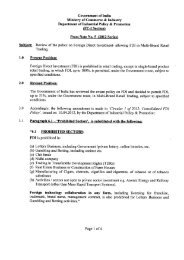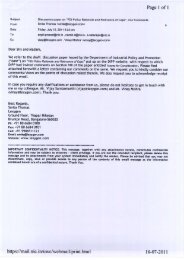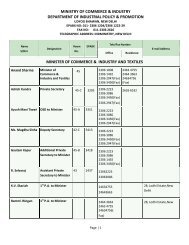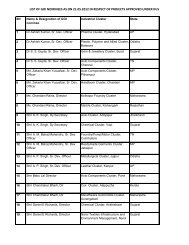fdi in india and its growth linkages - Department Of Industrial Policy ...
fdi in india and its growth linkages - Department Of Industrial Policy ...
fdi in india and its growth linkages - Department Of Industrial Policy ...
Create successful ePaper yourself
Turn your PDF publications into a flip-book with our unique Google optimized e-Paper software.
SECONDARY DATA-BASED ANALYSIS<br />
6.3.4 Employment Generation<br />
The total number of people employed <strong>in</strong> FDI plants is about 15,64,920 (Table 6.34).11 This amounts to a share of<br />
between 4 <strong>and</strong> 5 per cent of the total labour force <strong>in</strong> the formal sector.12 More than 50 per cent of the total employment<br />
<strong>in</strong> the FDI manufactur<strong>in</strong>g sectors orig<strong>in</strong>ates <strong>in</strong> small cities. The top-25 NIC 3-digit sectors account for 80 per cent of<br />
the total FDI employment <strong>in</strong> large cities <strong>and</strong> 86 per cent of the total FDI employment <strong>in</strong> small cities. The share of<br />
employment <strong>in</strong> small cities varies across NIC sectors; it is relatively high <strong>in</strong> sectors where employee cost is higher than<br />
the overall average of 45 per cent orig<strong>in</strong>at<strong>in</strong>g <strong>in</strong> small cities.<br />
Two sectors that provide relatively high shares of total employment <strong>in</strong> FDI plants <strong>in</strong>clude chemical products (242) <strong>and</strong><br />
grow<strong>in</strong>g <strong>and</strong> process<strong>in</strong>g crops, <strong>in</strong>clud<strong>in</strong>g tea <strong>and</strong> horticulture (011). While 3-digit NIC Sector 242 provides employment<br />
to about 16 per cent of the total employment <strong>in</strong> FDI firms, the correspond<strong>in</strong>g value for NIC Sector 011 is about 14 per<br />
cent. While 49 per cent of the employment generated by chemical products orig<strong>in</strong>ated <strong>in</strong> small cities, the correspond<strong>in</strong>g<br />
proportion is 93 per cent <strong>in</strong> process<strong>in</strong>g crops, <strong>in</strong>clud<strong>in</strong>g tea <strong>and</strong> horticulture (011).<br />
Employment orig<strong>in</strong>at<strong>in</strong>g <strong>in</strong> FDI manufactur<strong>in</strong>g firms varies widely across states (Table 6.35). About 20 per cent of the<br />
total employment is <strong>in</strong> Maharashtra. The correspond<strong>in</strong>g share is 12.5 per cent <strong>in</strong> Karnataka, 8.8 per cent <strong>in</strong> West Bengal,<br />
7.4 per cent <strong>in</strong> Haryana, 6.9 per cent <strong>in</strong> Assam, 6.3 per cent <strong>in</strong> Tamil Nadu, 6.2 per cent <strong>in</strong> Gujarat <strong>and</strong> 5.8 per cent <strong>in</strong><br />
Andhra Pradesh. These eight states account for about three-fourth of the total manufactur<strong>in</strong>g FDI sector employment.<br />
Other states account for lower employment shares.<br />
While Maharashtra has only about 19 per cent of the total employment <strong>in</strong> FDI plants <strong>in</strong> small cities, the proportion is<br />
nearly 100 per cent <strong>in</strong> the case of Assam. The correspond<strong>in</strong>g proportion is 21 per cent <strong>in</strong> Karnataka; 82 per cent <strong>in</strong><br />
Haryana; 39 per cent <strong>in</strong> Tamil Nadu; 57 per cent <strong>in</strong> Gujarat; <strong>and</strong> 40 per cent <strong>in</strong> Andhra Pradesh. Thus, FDI plants <strong>in</strong><br />
Assam, Gujarat <strong>and</strong> Haryana have relatively high proportions of employment <strong>in</strong> small cities.<br />
6.3.5 Export Intensity<br />
FDI firms account for 13 per cent of the total sales turnover <strong>and</strong> 12 per cent of export by all firms, both domestic <strong>and</strong><br />
FDI (Table 6.36). FDI firms have a sales turnover of Rs, 2,994 billion out of the total sales turnover of Rs. 22,665 billion<br />
(FDI <strong>and</strong> domestic firms taken together). Exports of FDI firms are valued at Rs. 378 billion out of total exports of<br />
Rs. 3,069 billion. While some sectors have a relatively low share of the contribution of FDI firms <strong>in</strong> total sales turnover<br />
<strong>and</strong> exports, others have relatively high correspond<strong>in</strong>g shares. FDI firms <strong>in</strong> 3-digit NIC sectors <strong>in</strong>clud<strong>in</strong>g ref<strong>in</strong>ed<br />
petroleum products (232), basic chemicals (214) <strong>and</strong> textiles (171) contribute sectoral shares much lower than the overall<br />
averages <strong>in</strong> sales turnover <strong>and</strong> exports. However, FDI firms play an important role <strong>in</strong> sectoral sales turnover <strong>and</strong> exports<br />
<strong>in</strong> sectors such as chemical products (242); electricity distribution <strong>and</strong> control apparatus (312); medical appliances <strong>and</strong><br />
<strong>in</strong>struments (331); motor parts (343); dairy products (152); transport equipment (359); m<strong>in</strong><strong>in</strong>g of iron ores (131); <strong>and</strong><br />
electrical equipment (319).<br />
About 13 per cent of total sales of FDI firms are exported. This is referred to as “export <strong>in</strong>tensity”. Some sectors have a<br />
relatively high share of exports <strong>in</strong> total sales, while others are on the low side. The correspond<strong>in</strong>g share <strong>in</strong> some of the<br />
important sectors is 80 per cent <strong>in</strong> m<strong>in</strong><strong>in</strong>g of iron ores (131), 50 per cent <strong>in</strong> basic precious <strong>and</strong> non-ferrous metals (272),<br />
31 per cent <strong>in</strong> software publish<strong>in</strong>g, consultancy <strong>and</strong> supply (722), 26 per cent <strong>in</strong> textiles (171) as well as <strong>in</strong> special purpose<br />
11.This number is computed by add<strong>in</strong>g sectoral employment. Sectoral employment is computed as the ratio of sectoral employee cost to sectoral wage rate;<br />
sectoral wage rate is taken from the Annual Survey of Industries (ASI), Government of India. This may be an approximation but we could not arrive at<br />
a better estimate.<br />
12.Based on 40 per cent workers' participation rate <strong>and</strong> 8 per cent share of the organised sector.<br />
65












